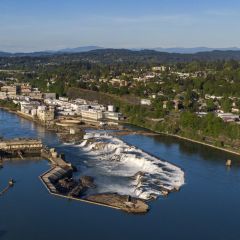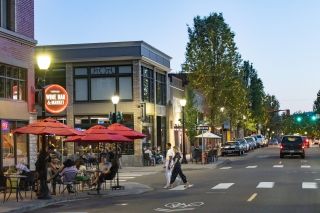
Oregon City
The former capital of the Oregon Territory, Oregon City is a historical delight.
Brian Barker
Oregon City boasts an impressive list of “firsts”: first incorporated city west of the Rocky Mountains (1844), Oregon’s first capital (before it was even a state) and the country’s first long-distance electric line (Willamette Falls to Portland, 1889).
But it’s actually Oregon City’s last-place status that fascinates many modern-day visitors: Located just 15 miles southeast of Portland, alongside the Willamette River and a dramatic, tiered waterfall, Oregon City served as the final wagon stop on the fabled Oregon Trail. And today, thanks to its rich history and recent historic restoration projects, Oregon City remains as much a destination as ever.
Oregon City served as the final wagon stop on the fabled Oregon Trail.
At the north end of town, the End of the Oregon Trail Interpretive Center provides an excellent glimpse of life along the historic route. Made up of several buildings beneath giant wagon frames, the Interpretive Center contains hands-on exhibits where costumed interpreters describe the challenges of packing for the cross-country trek. Little explorers can get hands-on with history here by dressing up, packing a wagon and trying their hands at pioneer crafts and activities like candle making. The “Bound for Oregon” video presentation and other exhibits also immerse visitors in historical tales and explain how Oregon City was the end of the trail for many because it was where land claims were granted for Oregon, Washington, Idaho and Wyoming.
The historic site is also home to the Country Store, where authentic keepsakes and locally made goods — like beaded items from Confederated Tribes of the Grand Ronde — are available for sale. Also on view is a Master Gardener’s Pioneer Garden, where plants and heirloom roses similar to those found in 1860s Oregon are on display. Expertly researched, the specimen roses are attended by master gardeners, who present plant life in pioneer times, a topic that, like Oregon, is still green today.



Tucked between the Willamette River and high-rising basalt bluffs, the compact downtown is easily explored on foot. The historic Arch Bridge (Seventh Street/Highway 43) is well worth a visit. Built in 1922, the 850-foot (259 m) span reopened in 2012 after an extensive two-year makeover, complete with refurbished, monumental columns, gothic-style lighting and wide sidewalks for taking in views of Willamette Falls, the Northwest’s largest by volume.
For an even more expansive vista, head up Seventh Street and board the Oregon City Municipal Elevator. Considered the only “vertical street” in the country, the space-pod-like structure rises 130 feet (39 m) to an observation deck with panoramic city and river views.
From the elevator, tour the scenic McLoughlin Promenade. Constructed in 1937 as a Works Progress Administration project, the nearly eight-acre linear park overlooks downtown and Singer Falls, another WPA-constructed site that showcases rustic stonework in a series of man-made waterfalls. The adjacent McLoughlin Conservation District includes the McLoughlin House, a manor built in 1846 for Dr. John McLoughlin, the founder of Oregon City.
Nearby the Francis Ermatinger House, erected in 1845, is one of the oldest structures in Oregon. The humble, federal-style residence is steeped in local lore: In 1845 two influential businessmen, Asa Lovejoy and Francis Pettygrove, famously flipped a coin here to decide the name of Portland. (“Boston” was the other choice.)
Returning to the promenade, stroll west, toward the falls, to delve deeper into the past at the Museum of the Oregon Territory, home to an extensive collection of Native American artifacts.
Nearby, the Highland Stillhouse Scottish Pub makes an ideal spot to toast the day. One of the best Scottish-themed bars around, it’s also an homage to yet another one of Oregon City’s firsts: The town claimed the territory’s first moonshine still. Today the Stillhouse boasts the Portland area’s most extensive single-malt selection and an authentic feel, right down to the woolly plaid bar seats. Order up traditional bangers and beans and Scotch eggs. Odds are your first visit won’t be your last.
Where to Eat in Oregon City
The Hive Social
Head to The Hive Social for brunch, where daily breakfast and brunch offerings run the gamut from aebleskiver to steak and eggs, a specialty “benny” menu (Egg’s Benedict) to lox and mussels. They’re also open for dinner and cocktails on Wednesday through Saturday.
Corner 14 Food Carts
The Corner 14 Foodcarts offers a selection of eateries, like Shawarma Express, Sizzling Tandoori Hut, From Russia with Love and more, with a full-service bar, indoor and outdoor fireside dining spaces, and even axe throwing.
Mi Famiglia
This family-owned Italian restaurant serves up salads and antipasto with beers and wines. The pizzas from the wood-fired brick oven at Mi Famiglia come with crispy crusts and toppings like prosciutto and fig or chicken pesto and bacon.

What to Do in Oregon City
Go Shopping
On Main Street you can browse shops like You Can Leave Your Hat On, where you’ll find all manner of hats and other accessories. At White Rabbit Books & Gifts find local color in a small selection of gifts and books. Flip through bins of vinyl at the unassuming Oregon City Records. Step into the past with several antique and vintage shops, like Maizee Mae’s Antiques & Vintage Flea Market and Gem Trail Vintage.
Go Wine Tasting
South of Oregon City proper, you’ll discover the East Willamette Valley vineyards like Villa Catalana Cellars, which offer tastings amid lush gardens. Nearby, King’s Raven Winery is owned by a family descended from pioneers. Further south, you’ll find Christopher Bridge and Forest Edge Vineyard for a thorough East Willamette Valley tasting tour.
Kayak Willamette Falls
Oregon City’s eNRG Kayaking offers guided tours of the second-largest waterfall by volume in the U.S. — by kayak. You’ll paddle through natural beauty as well as industry and be rewarded with spectacular views of Willamette Falls.

Credit: Travel Oregon / Mountains Legacy
Explore Canemah Bluff
Stroll through Canemah Bluff Nature Park for views of spring wildflowers, like camas and white larkspur, and the Willamette River. With a little over 1 mile (1.6 km) of trail wending through Douglas firs and rare Oregon white oak, you might find deer grazing or sparrows, orange-crowned warblers, hawks and eagles on these easy and accessible trails.
Was this page helpful?